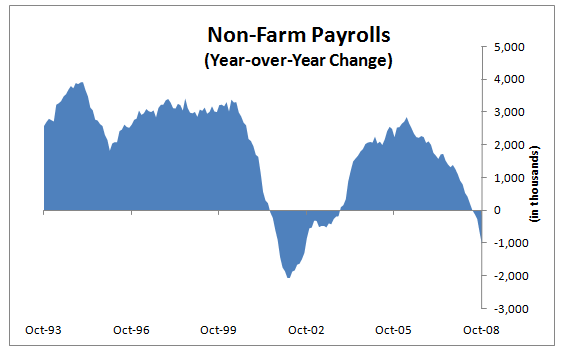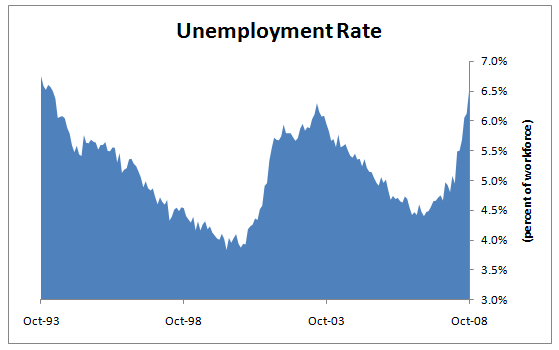US unemployment rate jumps to 6.5%
After stalling at 6.1% in September, the U.S. unemployment rate jumped to 6.5%. This was a truly ugly report as we saw payrolls go down by 240,000 – more than forecast and September was revised up significantly from 169,000 to 284,000. August was revised up 54,000 as well. These were enormous revisions, putting total job losses at 1.179 million since January.
Given the large number of layoff announcements recently, we should expect this rate to rise significantly based on expected job losses alone. A rate over 8% in 2009 is certainly well within the range of possibilities. Looking at the second chart below, one can see that non-farm payrolls dipped by a much greater amount in the recession of 2001 than the dip we have seen to date in 2008. Given this recession is much deeper, it suggests we will see millions more jobs lost in the coming months.

The unemployment rate has very much underestimated the economic pain being felt in this recession. There a number of reasons why: the increasing number of workers accepting lower pay and accepting part-time or temporary positions, as well as the decrease in those actually looking full time for employment. Yesterday, Barry Rithotz had a very good post on this.
Does that relatively mild U3 unemployment rate accurately portray the employment circumstances? U3 is the official UE rate, but the BLS also reports a full — and much uglier measure — U6. I’ve long said that the U6 number is more accurate, and more and more people are recognizing that as the case.
Dan Gross of Slate and Newsweek has been in the same camp for quite a while. A column of his from October is worth resurrecting prior to tomorrow’s Employment Situation Release. NFP. Dan observes:
“It’s hard to overstate the poor numbers coming out of Wall Street in recent months. But could it be that we’re overstating the gravity of the situation? As job losses have mounted and consumer confidence has plunged, policymakers, news organizations, econo-pundits, and even some of my Slate colleagues have noted that the unemployment rate, which rose to 6.1 percent in September, seems to be at a nonrecessionary, noncatastrophic, low level. The unemployment rate is still below where it was in 2003; and between September 1982 and May 1983, the last very deep recession, it topped 10 percent.
But maybe the employment data are much worse than they seem. In the past year, the two key measures of employment—the unemployment rate and the payroll jobs figure—have been poor but not awful. The unemployment rate has risen from 4.5 percent a year ago to 6.1 percent. And in the first nine months, 760,000 payroll jobs were lost. This is unwelcome but not catastrophic. So why do things feel so bad? It’s not because, as Phil Gramm suggested, we’re a nation of whiners. And it’s not a matter of columnists and spin doctors shading the numbers to make things look worse.
Rather, these two figures are undermeasuring the weakness in the labor market. By some measures, in fact, the job situation is worse than it has been at any time since 1994.
Exactly.
Wanna know why? Major changes in the BLS methodology since the 1990s since 1994.
Sources
Undercounting Under-Employment – Barry Ritholtz

Who wants to help do something about this?
-Workpost.com